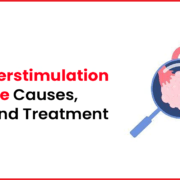Uterine Fibroids: Causes, Symptoms & Treatment
A uterine fibroid is an abnormal non-cancerous tumour that grows in or along the outline of the uterine cavity. Another common name for uterine fibroids is myoma.
The Uterine Fibroid also known as:
- Fibromas
- Leiomyomas
- Uterine myomas
Fibroids start to grow from the muscle tissue of the womb (uterus). They are also found to grow in the cervix, fallopian tubes, or tissues surrounding the uterus.
The reason behind uterine fibroids is unknown. Uterine fibroids can be as tiny as a seed or as large as a melon. A woman may have one or many fibroids.
As already mentioned, fibroids are non-cancerous. Also, a majority of women with uterine fibroids do not witness visible symptoms. So, a woman may never know if she has fibroids.
Fibroids are more prevalent in obese women and women who are more than 35 years of age with no children.
In this article, we are going to look at the different types, associated symptoms, causes, diagnosis, and treatment of uterine fibroids.
Types of uterine fibroids

Uterine fibroids are classified based on their location as discussed below:
-
Intramural Fibroids
The most common kind of uterine fibroids are intramural fibroids. These fibroids grow in the muscular wall of the womb. These are diagnosed between 30 to 40 years of age.
-
Subserosal Fibroids
These uterine fibroids are mostly non-cancerous and grow on the outer surface of the uterus, known as serosa. Subserosal fibroids tend to grow quite large, which makes the uterus appear larger on one side. In rare cases, these fibroids can interfere with the functioning of the uterus.
-
Submucosal Fibroids
These fibroids grow under the surface of the endometrium lining. These fibroids are the least common but cause serious problems like anaemia.
-
Pedunculated Fibroids
These fibroids get their name from the word peduncle, which means a stalk-like growth. When fibroids are attached to the womb by a peduncle, these are termed pedunculated fibroids. If these fibroids grow inside the uterus then these are known as pedunculated submucosal fibroids. If these grow outside the womb then we call them pedunculated subserosal fibroids.
-
Cervical Fibroids
These very rare fibroids grow on the cervix and are hence termed cervical fibroids.
Uterine Fibroid Symptoms

Typically, no visible symptoms are associated with uterine fibroids. Visible symptoms are generally noticed in the following three situations:
- When the size of the fibroids is quite large
- The number of fibroids
- location of the fibroids
Some of the most common symptoms associated with fibroids include the following:
- Heavy Menstruation
- Prolonged Periods
- Extreme Pain during Periods
- Menstrual Clots
- Feeling Pain or Pressure in the Pelvic Region or lower back
- Abdomen Enlargement or Swelling
- Constipation
- Anaemia
- Backache
- Frequent Urge to Urinate
- Pain during Intercourse
Fibroid Growth during Menopause
Fibroid growth is quite common after Menopause. When a woman undergoes Menopause, the oestrogen and progesterone levels witness a drop. Both these hormones are known to stimulate the growth of uterine fibroids. There is also a possibility that these fibroids may shrink during or after Menopause. You may not come across any symptoms of fibroid growth.
Complications associated with the presence of uterine fibroids are rare. Some of these rare complications are:
- If the size of the fibroids is large then it may hamper fertility by blocking the fallopian tubes and preventing the egg from getting implanted.
- Pregnant women might face some difficulties during labour due to fibroids.
- In some cases, fibroids may lead to miscarriage or premature birth.
Uterine Fibroid Causes
The cause of fibroid is still a mystery. However, medical experts believe genetic and hormonal factors govern the growth of fibroids in women.
The pregnancy hormone oestrogen, which is active during a woman’s reproductive age, is known to play a role in the development of fibroids.
When a woman is on her period, the uterine lining gets regenerated because of the pregnancy hormones estrogen and progesterone. This regeneration stimulates the growth of uterine fibroids. These fibroids may shrink during Menopause.
Family History
Also influences the growth of fibroids. If your grandmother, mother, or sister had fibroids, then you may also notice fibroid development.
Age also has a role to play in fibroid growth. Women who are 30 years old or older are at a higher risk of developing uterine fibroids.
High body weight also influences the development of uterine fibroids.
Fibroids may also grow during pregnancy. During this time, the production of estrogen and progesterone increases. However, the chances of pregnant women developing fibroids are far lesser than non-pregnant women.
When to See a Doctor?
Fibroids generally do not lead to any complications. So they do not need medical attention. But in case of menstrual irregularities or disorders like frequent or heavy bleeding, you should visit a IVF treatment Centre near you.
Diagnosis of Uterine Fibroids
It is not possible to confirm the presence of fibroids without visiting a IVF expert who will run some diagnostic tests and develop a further treatment plan if needed.
Here are some tests to examine the presence of fibroids:
- Pelvic examination-: In a pelvic examination, the gynaecologist will check the condition of the vagina, the uterus, and both ovaries.
- X-ray-As the name suggests, this test uses X-rays to produce clear pictures of the uterus.
- Pelvic Magnetic Resonance Imaging- This in-depth imaging test helps produce images of ovaries, uterus, and other pelvic organs by using magnets and radio waves.
- Ultrasound-This test is performed on the abdomen with high-frequency sound waves used to produce images of the internal structure of the uterus and fibroids, if any.
- Computed tomography scan- Popularly known as CT scan, makes use of X-rays to examine the presence of fibroids in or on the uterus from different angles.
- Laparoscopy-: In laparoscopy, thin cuts are made near the navel, and a thin, long scope finds its way into the uterus through these cuts to check for the presence of fibroids.
- Hysterosalpingogram (HSG): The HSG test uses a contrast dye that is injected into the womb, and simultaneously X-ray pictures are produced to detect fibroids.
- Sonohysterogram: This test is carried out by injecting water into the uterus, which helps in the production of images using ultrasound.
- Hysteroscopy: Hysteroscopy is performed with the help of a long and thin scope with a light attached to its end. It is then directed through the vagina and cervix into the uterus to detect fibroids.
Natural ways to treat or prevent further growth of uterine fibroids
Be it any complication in the body, food, and lifestyle choices can make or break the deal. If you do away with poor dietary and lifestyle choices and opt for the below-mentioned options, then you can witness some positive changes.
Make sure you keep your body healthy and keep your body weight in control by:
- Practicing yoga
- Acupuncture
- Massage
- Exercising regularly
The food you eat also plays a huge role, so include the following in your diet:
- Green leafy vegetables
- Green tea
- Tuna and Salmon
Another important point is to avoid red meat, ham, and high-calorie processed food.
Treatment of Uterine Fibroids
When talking about the treatment of fibroids, people think that surgery is the only available option. But in the majority of cases, there is no need for surgical intervention. The treatment option depends on the location, number, and severity of fibroids.
Various treatment options available in the form of medications to treat fibroids are as follows:
- Hormone medications: Your health provider can prescribe some hormone medications to help shrink the fibroids.
- Medications for period pain: Medications like ibuprofen and acetaminophen can help alleviate period pain.
- Hormone-releasing device: It is placed in the womb, which helps keep heavy menstruation in control.
- Supplements: Take Vitamin D or Iron supplements to manage heavy menstrual bleeding.
If the complications are more severe and medications don’t seem to help, then the following surgical options can help:
- Radiofrequency ablation: Radiofrequency ablation surgery makes use of heat to destroy and shrink fibroid tumours without affecting the tissues surrounding them.
- Myomectomy: This surgical operation removes fibroid tissues without causing any harm to surrounding healthy tissue present in the womb.
- Endometrial ablation: For this, the surgeon destroys the uterine lining with the help of a laser, wire loops, boiling water, electric current, microwaves, or freezing. Endometrial ablation greatly helps to reduce heavy menstrual bleeding. Medical experts advise you to opt for this surgery only if you have no plans of conceiving a baby in the future.
- Myolysis: This surgical operation is used to destroy fibroid tissues using electrical current or freezing with the help of a needle.
- Uterine fibroid embolization (UFE) or Uterine artery embolization (UAE): This surgery is undertaken to shrink fibroids. A thin tube is placed in the blood vessels of the fibroid tissue. Then, gel particles are injected into these vessels to block the supply of blood to the fibroid.
- Hysterectomy: In this medical procedure, the entire womb (uterus) is taken out. This surgery is performed when the size of the fibroids is quite large or when uncontrolled menstrual bleeding. Just like endometrial ablation, hysterectomy should only be considered as an option when you have no plans to become pregnant in the future
Bottom line
Uterine fibroids have become common these days. These are largely non-cancerous, so they do not warrant urgent medical attention or treatment. Medications or treatment options should only be taken into consideration if there are severe complications due to the presence of fibroids; otherwise, there is no harm in living with fibroids.
But it is very important to see a doctor if you feel the need to do so. Also, take care of your reproductive health by adopting healthy eating habits, staying active, and keeping stress levels under control.










